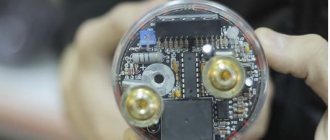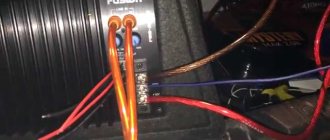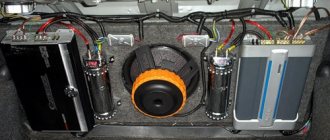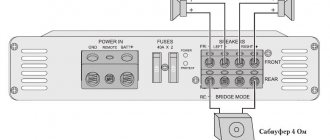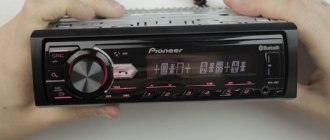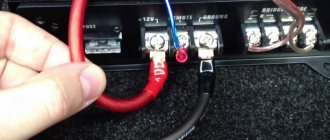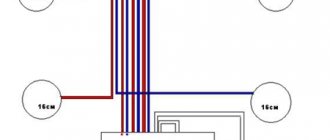September 19, 2022 When building an audio system, a situation may arise when the existing speaker has a resistance that is less or more than what the amplifier allows. If you have two similar speakers, you can simply connect them in series or parallel and get the desired impedance.
However, in practice (especially for car audio), other more exotic scenarios are more common, for example, a subwoofer with two coils, or a powerful amplifier and two not very powerful subwoofers. There are many connection options and this raises questions for many. Here are some of the most common subwoofer connection diagrams.
I will add that for high-quality sound it is advisable to use identical subwoofers. Also, if you have the opportunity to use one source instead of two, it is advisable to do so - in most cases, one source sounds better than several. Exceptions are specialized schemes in which the relative position of sources, interference, the shape of the wave front and the like are specially calculated.
To begin with, the simplest option.
Connection options for single coil subwoofers
In most cases, for subwoofers with one coil, everything is more or less obvious, so further we will consider only subwoofers with two coils.
One subwoofer with two 2 ohm coils
A subwoofer with two 4-ohm coils can be connected in the same way: when two 4-ohm coils are connected in series, the amplifier will operate at 8 ohms, and when connected in parallel, the amplifier will operate at 2 ohms.
Most of the difficulties are caused by connection diagrams with two dual-coil subwoofers. There are many connection options, but the principles are still the same.
Two subwoofers with two coils of 2 ohms or 4 ohms
Car subwoofers use different types of loudspeakers. They differ in power, frequency range and voice coil resistance. Low-frequency loudspeakers use speakers with winding resistances of 4, 2 and 1 ohms. In addition to speakers with one speaker, in practice, acoustic systems with two loudspeakers or speakers with two windings are often used. Each LF system has its own connection features.
Connecting a subwoofer 2 X 2
Low-frequency systems with two loudspeakers are often installed in cars. They provide great power, deep and rich bass. The connection diagram for a 2 X 2 subwoofer may differ from other options. This design can be made in the form of a closed box or work with a bass reflex. Connecting a 2 X 2 subwoofer can be done in two simple ways. This is a series or parallel connection of loudspeaker voice coils. In order to calculate the resulting resistance, a simple formula is used. The voice coil winding is a low-resistance resistor. When two 2 Ohm coils are connected in series, the total resistance is 4 Ohms, based on the formula R total = R1 + R2 or 2 Ω + 2 Ω = 4 Ω.
The connection diagram for a 2 X 2 subwoofer at 4 Ohms does not cause any difficulties, since almost all low-frequency amplifiers operate with such a load. The formula for parallel connection of resistances looks a little different. Here the resulting resistance of several resistors will be less than the smallest resistance of the parallel circuit. According to the formula Rtotal=R1*R2/R1+R2, the resistance of two 2 Ω coils connected in parallel will be equal to 1 Ω. Connecting a 2 X 2 in 1 subwoofer is associated with some difficulties, since not all models of low-frequency amplifiers can work correctly with such a load impedance. Each connection has its own specifics. If in the subwoofer connection diagram there are 2 X 2, the windings of the voice coils are connected in series, then the power will decrease by about half. Since one speaker with an impedance of 2 provides a nominal power of 500 watts, connecting a second speaker in parallel with the same impedance will reduce the system output power to 350 watts.
Series, parallel and mixed speaker connection
The most important thing when connecting speakers is to make the connection so that neither speaker is overloaded. Overloading threatens to damage the speaker.
It is important to understand that the speaker can be supplied with power either less than or equal to the rated power for which it is, in fact, designed. Otherwise, sooner or later even the highest quality speaker will fail due to overload.
It is clear that before connecting the speakers you need to define them:
Rated power ( W , W );
Active resistance of the voice coil ( Ohm , Ω ).
All this, as a rule, is indicated on the magnetic system of the speaker, or on the basket.
1W means 1W, 4Ω is the resistance of the voice coil.
Speaker brand - 3GDSH-16 . The first number 3 is the rated power, 3 W. Next to it is the signature - 8 Ohm, coil resistance.
Sometimes they don’t indicate it, but you can recognize it by the markings.
Mid-range speaker 15GD-11-120 . Rated power - 15 W, coil resistance - 8Ω.
Speaker connection. Example.
Let's start with the basics, so to speak - clear examples. Let's imagine that we have a 6-watt audio power amplifier (AMP) and 3 speakers. Two 1 W speakers (coil resistance 8 Ω each) and one 4 W speaker (8 Ω). The challenge is to connect all 3 speakers to the amplifier.
First, let's look at an example of these speakers being connected incorrectly. Here is a visual drawing.
As you can see, the resistance of all three speakers is the same and equals 8 Ω. Since this is a parallel connection of speakers, the current will be divided equally between the 3 speakers. At maximum amplifier power (6 W), each speaker will receive 2 W of power. It is clear that 2 out of 3 speakers will be overloaded - those whose rated power is 1 W. It is clear that such a connection scheme is not suitable.
If the amplifier outputted only 3 W of sound power, then such a circuit would be suitable, but a 4 W speaker would not work at full capacity - “filonil”. Although this is not always critical.
Now let's take an example of the correct connection of the same speakers. Let's use the so-called mixed connection (both serial and parallel).
Let's connect two 1-watt speakers in series. As a result, their total resistance will be 16 Ω. Now we connect a 4-watt speaker with a resistance of 8 Ω in parallel to them.
When the amplifier operates at maximum power, the current in the circuit will be divided based on the resistance. Since the resistance of a series circuit of two speakers is 2 times greater (i.e. 16 Ω), the speakers will receive only 2 watts of sound power from the amplifier (1 watt each). But a 4-watt speaker will use 4 watts of power. But it will work according to its rated power. There will be no overload with such a connection. Each speaker will operate normally.
And one more example.
We have a 4-watt audio power amplifier (UMZCH, aka “amplifier”). 4 speakers, the power of each is 1 watt, and the resistance of each is 8 Ω. A load with a resistance of 8 Ω can be connected to the amplifier output. You need to connect the speakers together so that their total resistance is 8 Ω.
How to connect a 1 ohm subwoofer
The subwoofer connection diagram in 1 ensures maximum power from the low-frequency unit and the highest volume level. However, the quality of bass reproduction will not be the best. Low frequencies will be “smeared out”. As the load resistance of the amplifier increases, the power will decrease, but the quality of low-frequency reproduction will noticeably increase. The blurriness of the sound will disappear, and the bass will become clear and deep. You cannot connect a 1 Ω subwoofer to every amplifier model. The description of some low-frequency units specifically stipulates the minimum permissible load resistance. Loudspeakers with a 1 Ω coil are rare, so this resistance is usually obtained by connecting two 2 speakers in parallel. Connecting a 2 X 2 in 1 Ohm subwoofer can be done by using one speaker with two 2 Ω windings. They always indicate the polarity. In order for the speaker system to work correctly, you need to connect the speaker contacts correctly.
The pros and cons of the voice coils are interconnected and connected to the corresponding contacts of the low-frequency amplifier.
How to connect a 4 ohm sub
Connecting a subwoofer at 4 is considered the most common, since most dynamic heads have such resistance, and all types of low-frequency amplifiers allow the use of such speakers as a load. You can organize a 4 ohm load using two 2 ohm speakers connected in series, when the plus of one speaker is connected to the minus of the other. The connection diagram for a subwoofer in 4 can be obtained using a two-winding speaker. Depending on their resistance, the connection configuration depends. Two coils of 8 connected in parallel will give, as a result, the required 4 Ohms. The same resistance is obtained if two voice coils with a resistance of 2 ohms are connected in series.
In the connection diagram for a subwoofer in 4, the minus of one voice coil is connected to the plus of the other winding, and the remaining free contacts are connected to the output of the low-frequency amplifier, observing polarity. Connecting two subwoofers of 4 is carried out in parallel or in series. Connecting a subwoofer 4 4 in 2 will provide increased power almost twice. The series resistance of the windings will be 8 Ω. The power will be reduced, but the bass performance will be bright and clear.
How to connect a two-coil subwoofer
Connection diagrams for a two-coil subwoofer are limited to the following several options:
- Parallel connection
- Serial connection
- Separate connection
Most often, the resistance of the windings of low-frequency speakers is 2 or 4 ohms. With a parallel connection, the total resistance will be half the resistance of each winding. It will be 1 or 2 respectively. A series connection will give a resistance of 4 or 8 Ω. By reducing the output power, the best sound quality is achieved at low frequencies. In addition, you can connect a subwoofer with two coils without connecting them, but by using each winding for a separate channel of the low-frequency amplifier. Connecting 2 coil subwoofers must be done with strict observance of polarity. It would be undesirable for an amplifier to connect a 2 Ohm subwoofer in a bridge connection.
Each amplifier channel will operate at 1 Ω, and this is a dangerous load for some models of low-frequency equipment. The power will increase, but at the same time the current will increase and nonlinear distortion will increase. The ULF output stages will operate in a critical mode and may fail. Separate connections are allowed only if absolutely the same signal is supplied to both channels of the amplifier.
Forum "Auto-HiFi"
Good evening, tell me what is the difference between Boston subwoofer models with one or two coils, and does the choice of wuxia depend on this? Thanks in advance :)
| Message | Creator |
| 2013-08-04 19:12:40 Hellion777 Special Address: Novorossiysk Messages: 106 | |
| The difference in resistance, the choice of amplifier directly depends on this. | 2013-08-04 19:57:04 Vadikan Veteran Address: Moscow Messages: 958 |
| It is from ignorance of this that beginners’ wuxi burns later. ) Read up on what overload is for an amplifier. and there is also a worldview that subs with 2 coils are the strongest!) | 2013-08-04 21:23:51 Kif Newbie Address: Yelets Posts: 2648 |
| The difference is in connection methods, 4ohm2ohm1ohm, etc. Vadikan quite correctly says that the choice of amplifier depends specifically on this. | 2013-08-04 21:29:28 Vik099 Newbie Address: Voronezh Posts: 2 |
| Thank you, can you give me a hint with examples of amplifiers for 2-coil. | 2013-08-04 23:08:41 Hellion777 Special Address: Novorossiysk Messages: 106 |
| There are different types of two-coil coils, there are 2x4Ohm, 2x2Ohm, 2x1Ohm. If the coils are connected in parallel, plus to plus, then the first option will have 2 ohms, the second 1 ohm, the third 0.5 Ohm.) Anything below 2 ohms is already considered extreme overload for wuxia.) The lower the resistance, the more power we give out, but the stronger it gets, the hotter it gets. And more distortion. In music systems, on the contrary, they try to connect subs at 8 ohms and use massive AB amplifiers. In pressure systems, the lower the resistance, the cooler!) They don’t care about musicality, as long as there’s pressure and everything shakes.) A small non-hazardous overload for wuxia is indicated in the wuxia manual. It must be respected. If it says 4 Ohm, 2 Ohm, 1 Ohm, then if you connect it to 0.5 Ohm it can burn out. If you connect the coils one by one, then you need to lay them down, i.e. 2x4Ohm, connected alternately, will be 8 As a rule, only monoblocks work at low loads. Ordinary 2-channel, 4-channel bridges lower than 4 ohms are not allowed to be connected. With very few exceptions.) But musicality from resistance is also a rather personal thing. ) for many people even in 1 ohm the sub sounds great) | 2013-08-04 23:14:27 Kif Newbie Address: Yelets Posts: 2648 |
| I’m not a fan of Davilov, musicality is much more important to me, so would it be better to take a 2-channel AB, 4 ohm, and connect it with a bridge? | 2013-08-04 23:27:31 Hellion777 Special Address: Novorossiysk Messages: 106 |
| The sub has 2x4 ohms of this | 2013-08-04 23:28:25 Hellion777 Special Address: Novorossiysk Messages: 106 |
| that means 2 ohms, look for the one that is playing. It would be nice to know what kind of sub! and take it depending on the budget and rated power of the subwoofer, for example, Mystery1,300, Kix.350, Kix600, Kix1000, Challenger 1000y, Eos 500y, DLS MAD 15. so that the rated power of the wuxia by 2 ohms is not less than the rated power of the subwoofer | 2013-08-04 23:42:46 Kif Newbie Address: Yelets Posts: 2648 |
| Kif I don’t understand where to write, I decided to write here, I wanted to thank you for the help, I still took the Alpine MRP-M850, the absolutely newest one for 6.5 rubles, I connected the Alpine SWR-12D4 into 2 ohms, it plays great, thanks for the help | 2013-08-04 23:55:25 RuS39 Occupant Address: Kaliningrad Posts: 38 |
| https://www.auto-hifi.ru/sab/model.php?mode=G312-44 this Sub is like 4 ohms. But do two coils need to be divided into two? | 2013-08-04 23:58:34 Hellion777 Special Address: Novorossiysk Messages: 106 |
| By the way, yes, I will support Rus39, thank you very much for chewing on the truths in detail :-) | 2013-08-05 00:00:56 Hellion777 Special Address: Novorossiysk Messages: 106 |
| Boston Acoustics G312-44 this sub is hard to find during the day, their creation has been completed | 2013-08-05 00:03:00 RuS39 Occupant Address: Kaliningrad Posts: 38 |
| I found the last one and will go pick it up tomorrow :) | 2013-08-05 00:46:24 Hellion777 Special Address: Novorossiysk Messages: 106 |
| It's a shame they don't make them anymore.( | 2013-08-05 11:20:32 Kif Newbie Address: Yelets Posts: 2648 |
How to connect a 2 to 2 sub
The connection diagram for a 2 Ohm subwoofer is carried out according to the classical scheme, when the speaker coil is connected to a low-frequency amplifier. It is better to connect a 2 Ω subwoofer, consisting of one loudspeaker, to a separate ULF channel, since when bridged, the low resistance of the coil can damage the system. In addition to a subwoofer with one speaker, a system of two separate 2 Ohm loudspeakers or a two-winding dynamic head can be used as a ULF load. By combining the connection of the voice coils you can connect a 2 2 in 4 ohm subwoofer. To do this, they need to be connected in series. Connecting 2 x subwoofers 2 2 is carried out with a large-section multi-core acoustic cable to avoid power losses due to heating of the connections. In order to connect two 1 ohm subwoofers, the 2 ohm voice coils must be connected in parallel.
Subwoofer connection 1 1
The 1 Ohm subwoofer connection circuit is not used often, since, despite the high output power, this mode does not provide good quality reproduction of low frequencies. Some models of low-frequency car amplifiers do not allow the connection of such a small load at all. Connecting two 1 Ohm subwoofers is only allowed when the windings are connected in series. A resistance of 0.5 Ω, which is obtained with a parallel connection, can destroy the amplifier. A bridge switching circuit will reduce this value by another factor of two. When connecting a 1 Ohm subwoofer, you need to remember that as the resistance decreases, the current increases, so all connecting cables must have the appropriate cross-section. Do not use single-core wires or cables intended for electrical wiring to connect high-power speaker systems.
How to connect two subwoofers to one monoblock
An acoustic low-frequency system can consist of one or two speakers. Columns in which a larger number of loudspeakers are installed are used extremely rarely due to their large dimensions. The following amplification systems can be used to organize a low-frequency channel:
- Monoblock
- Two channel amplifier
- Four-channel ULF
A monoblock is a separate amplifier that works only on the low-frequency channel. The connection diagram for two subwoofers to a monoblock depends on the resistance of the voice coil winding. If it is equal to 4 Ohms, then both parallel and series connections of windings are allowed. As a result, the total resistance of the speaker system can be 2 Ohms or 8 Ohms. Connecting a subwoofer 8 Provides the highest quality bass reproduction with a minimum of non-linear distortion. This configuration is the safest for a low-frequency unit, since the currents in the amplifier circuits will be small and the elements of the output stages will not overheat. You can connect 2 subwoofers with speakers of 2 Ohms each to the monoblock. In this option, only a serial connection is allowed if the car uses an AB class amplifier. If the basis of the low-frequency system is ULF class D, then parallel connection of loudspeakers with a total resistance of 1 ohm is allowed.
In addition to speaker systems with two speakers, speakers with two windings are often used in low-frequency channels. Typically, such heads have a winding resistance of 2, 4 or 8 ohms. You can connect a two-coil subwoofer to a monoblock, as well as separate speakers, in several ways. Since there are two coils, their separate connection to the monoblock is impossible. To do this, you need to use a two-channel or four-channel amplifier. The connection diagram for a 2 X 2 Omak monoblock subwoofer allows parallel connection of windings for ULF class D and only serial connection for other classes of amplifier equipment. The most common mistake when connecting a 2 X 2 sub is using only one winding. Some people believe that there is only one channel in a monoblock and it is enough to connect only one winding. Testing of speakers with two coils and different connection schemes showed that when only one coil is connected to the output of a low-frequency amplifier, the sensitivity of the speaker system decreases by approximately 3 dB. Therefore, you can connect a subwoofer to a monoblock only by connecting both windings.
“Every little one knows, black is a minus, red is a plus!”
see also
Comments 72
Is it possible to connect CT 12 (2+2) at 2 Ohms to Zeus 1.1000 (has 2 pairs of terminals, but it is not known whether they are duplicated or independent)? Thank you
Hello guys everyone. Can you give me some advice too? Amplifier kick rts 4.60 (4 ohm) sub oris two pancakes (1 ohm) two coils. How can I connect a sub so that it hits 4 ohms? Four fronts are connected to the same front. Maybe it’s easier to install an additional amp or wire up the sub itself? I hope I described it in as much detail as possible
Where do you get the plus minus when connecting 3 subs with one coil?
And so the question is, I didn’t find a diagram for myself, the sub is a custom former def bonus 123, the coils have been converted to 0.5+0.5 ohm resistance, the m2000d monoblock machete, how to connect it to 1 ohm? A diagram, at least in words. I would be very happy, I’m afraid I’ll burn it, it’s a little expensive.
There is a two-reel Mystery MO12S sub and a monoblock MR1.300, also a Mystery. What is the circuit for it so that it works from a 2 ohm amplifier? If I understand correctly, then according to scheme 10?
author, of course I’m sorry, but parallel switching of one subwoofer with two 4 ohm coils, wouldn’t it be 1 ohm? After all, they divide, that is, it turns out 4_4 = 1 Ohm. Or am I wrong?
Not right. With series -4+4=8 Ohms With parallel - 1/R total R total= 1/4+1/4, therefore 1/(1/4+1/4) = 1/0.5=2 Ohms. Everything is simple, if there is 1 sub with 4 ohm coils it is only either in 8 or 2, if it is 2 ohms - in 4 or 1 ohm.
blah, Thank you, now everything has fallen into place. I felt ashamed, I was trained as an electrician and didn’t understand how to connect the coils. PPC
bookmarked)))useful, but... I’m a beginner sound engineer, so I have a question. How will it be correct to connect the alphard machete m15d2 (coils 2+2) to the Kixar 1.350 (2 Ohm: 600 W x 1, 4 Ohm: 350 W x 1)?
I will be very grateful for your answer)))
How to connect a sub with a double coil 4+4 in 4 Ohm using both coils?
Greetings, please tell me if I understood correctly how to connect the sub, the monoblock amplifier has 4 terminals - 2 plus, 2 minus, on the sub there are 2 coils of 2 ohms. I connect one plus and minus from the amp to one coil of the subwoofer, the second plus and minus to the second coil and it turns out to be connected in 1 ohm?
Please tell me. How to connect in 1st? Sub Ural Armada 2+2 coils.
one sub 2+2 and 4 channels, will there be any losses when connecting?
Hello everyone, please tell me how to connect 3 subwoofers with 4+4 coils, and how many ohms will be the result?
Hello. Is it possible to connect a 2-channel amplifier with one channel to the sub and the other to the rear speakers?
Maybe. But here is another question: the power of one channel for driving the subwoofer is negligible and the remaining one channel to the rear will be MONO. There is no point in such a connection at all.
Hi all. Tell me sub macheta 15d4. Two coils 4+4 Ohm. how to connect it to a monoblock for stronger pressure. I haven't purchased a monoblock yet. And what kind of candy bar can be connected to it (budget)
Circuit #12 Will work at 2 ohms.
Guys, I have an Alphard Hannibal SD 152 and a Kicx AR 1.350, you can feed it in 1, 2, and 4 and nothing will happen to it, as I understand it? So the sub is rated at 350W, when connected in the 4th ohm it gives 350W, and in the 1st ohm it gives 1000W, and the sub has a peak of 1000W. If I connect it in the 1st ohm, can it be covered? And what is the best way to connect it?
I don’t understand something, should I answer or what?
I don't know what to answer. there will be no pressure in the 8th. in your case, the most successful connection is through a monoblock at 2 ohms. It is much easier to burn a sub with a lack of power than with too much power. What you wrote is that you are trying to make a system not according to your mind, but to cobble together it from what is available. Nothing will come of this traveler's approach. There are amplifications that are not designed for 2 ohms, but in practice I feel very good at 2 ohms. for example kick cap 29.
Well, it would be like that right away, thanks for the answer, but it’s over, I knew it, just as you said, I wanted to create something from what I had, at least it would be a little bit of use from what I wrote if there was a stupid 2 ohm resistor to 2 ohms for screwing up? I’m interested in this... this is for the sake of an experiment for a while, then I’ll take the sub at 4 ohms exactly
theoretically it will work. but I don’t know how it will work in practice. I've never tried to connect like this. Here, only through experimentation will it be possible to find out anything.
I understand, it’s just damn it and I can’t really google exactly my question, it turns out that it’s not at all what I need))
I would still try to connect it to two channels at 2 ohms. Quite often it works fine. But the possibility of burning the amplifier still remains.
I have a 2-channel weak 60-watt nominal, but I have a 4-channel which with a 2-ohm bridge will produce about 600 watts nominal, they write on the internet that it seems like I can handle it, and even if something happens, it should go into defense
I am tormented by a question, I have a 4+4 ohm two-coil din, that is, I can either use 8 ohms or 2 ohms, can I connect it to 2 ohms plus through a 2 ohm resistor to get 4 ohms resistance? Will there be any pressure more than 8 ohms with such a circuit? I’m asking this because I’m afraid to burn out the sub in 2ohm, and the bridge I sat on is not intended to play in 2ohm.
1 sub coil 1+1 how to connect it in 2 ohm?
sequentially: minus and plus among themselves, others minus and plus to the amplifier
hi, is it that it turns out that one coil will just work? I don’t understand? Can you draw a diagram on a piece of paper that is clearer?
Look at diagram No. 4 and connect it the same way.
Already done, thanks for responding buddy!
hi, is it that it turns out that one coil will just work? I don’t understand? Can you draw a diagram on a piece of paper that is clearer?
or according to scheme No. 9
added to bookmarks)
Please tell me a diagram of how to connect two subwoofers, but the only problem is that they have different resistances. one has 2x4 ohms and the second has 2x2 ohms. Is it possible to connect in 1 Ohm?
tell me what the difference is if one sub with two 4 ohm coils plays at 8 ohm or at 2 ohm, what will be the difference?
By sound: In the 8th. will play very clearly, but there will be little pressure... in the 2nd. vice versa.
and as I understand it, at 8 ohms the sub will live longer
Tell me how to use a 4-ohm nick and two low-power 8 ohm nicks so that they work separately, that is, either one 4 ohm or two 8 ohm mics
In order to connect three dins with two coils of 2 ohms at 1.33 ohms, do you need to set the minus to one, and the plus to three? Did I understand everything correctly?
Very understandable, but I can’t find mine, can you help? Here I have one sub with 2 coils of 4 ohms, in the amplifier in the bridge there are 4 ohms, therefore I can connect one coil to the amplifier bridge and that’s it, and the second coil will be empty, right? Will the equipment be damaged?
2 coils of 4 ohms can be connected to 2 ohms or 8 ohms. If the amplifier does not support operation in 2 ohms, then you can only connect it in 8 ohms, but with such a connection, most likely the amplifier will not have enough power. in your case, it is better to buy a monoblock that will work stably at 2 ohms.
Yes, it will definitely be bought for the New Year! But now I'm afraid to check it. what if I just connect one coil to the bridge? what will happen? In my opinion, if I make 8 ohms out of 2 coils, the amplifier will simply burn out!
How to connect a subwoofer to an amplifier
Single channel connection
Connecting a subwoofer to an amplifier is not difficult; just connect the amplifier's audio output jack to the subwoofer coil or coils using speaker wires.
The wires should not be thin. In most cases, choose copper wiring with a cross-section of 4 mm and there will be no problems.
Connecting speaker wires
This subwoofer connection diagram is suitable for one channel of an amplifier or monoblock.
Monoblock is a single-channel amplifier designed specifically for subwoofers.
Connecting to a subwoofer via terminal block
Connecting to a subwoofer directly
Connecting a subwoofer with a bridge
In the case of using a multi-channel amplifier, the sub can be connected to two channels simultaneously, using the minus of one and the plus of the other, this connection is called bridged, with this method the power output by the amplifier increases significantly (see the specifications for specific numbers).
So you can connect a subwoofer to a two or four channel amplifier, using 2 channels for acoustics, and the remaining 2 for the subwoofer.
To connect a subwoofer with a bridge, make sure that your amplifier supports this feature.
If you connect a low-frequency speaker to an amplifier by changing the polarity, that is, connect the plus of the subwoofer to the minus of the amplifier output and vice versa, then the speaker will work in antiphase, there is nothing wrong with that, sometimes such a connection is used intentionally if the amplifier does not have phase adjustment (more about adjustment phases).
Connecting the subwoofer coils
The technical documentation for the subwoofer states the resistance of its coils (1 Ohm, 2 Ohm, 4 Ohm, rarely 0.5 Ohm), and the technical documentation for the amplifier indicates what resistance it can work with, this information is needed so that you connect correctly and effectively subwoofer to amplifier. The lower the resistance of the sub, the more power the amplifier will produce, provided that it can operate at this resistance. A subwoofer speaker may have several coils (1 or 2, rarely 4).
When the coils are connected in series, the resistance increases, while in parallel it decreases. If you don't want to learn definitions and count fractions, just save this cheat sheet (parallel and serial connections).
How much ohm to connect the subwoofer
The higher the resistance, the better the sound quality; the lower, the more power the amplifier delivers. If you need a lot of loud bass, then turn it to the minimum that the amplifier can provide, and if the overall sound quality of the system comes first, then it is 2 Ohms or 4 Ohms, depending on the power output.
Video on how to connect 2 subwoofers or more. Subwoofer connection diagram 2×2 Ohm, 4×4 Ohm, 1×1 Ohm. Serial connection of speakers. Parallel connection of speakers. Basic principles.
Happy connections!
Where to install
As a result, the resistance is equal to 1 Ohm. The standard option would be to connect two speakers and one subwoofer. It is also possible to route two subwoofers into separate rear channels.
To do this, it is advisable to choose wires with a large cross-section.
Two wires are used to connect the speaker, the remaining ones can simply be hidden from view. In most cases, a properly selected speaker system allows you to achieve good quality of broadcast music. In this article we will try to figure out how to properly connect a subwoofer to an amplifier.
Before installing the subwoofer and amplifier, you need to decide where exactly the car amplifier will be located. For different speakers connected together, the impedance can be calculated easily by finding a formula on the Internet. If you have experience and knowledge in radio electronics, connecting a subwoofer to a radio tape recorder will not require much time and effort.
Before you start connecting the active and passive subwoofer to the amplifier, it makes sense to compare the RMS values of the power at which the equipment can operate with a real sound signal for an hour without damaging the subwoofer and amplifier. In order for everything to work correctly, it is necessary to take into account a number of quite important parameters.
This is one of the schemes that allows you to connect a two-coil sub. Those who prefer the loudest bass possible may need a level of 40 Hz. At the same time, the current increases, and, consequently, the power. To the standard radio To connect the subwoofer to the standard radio, you first need to check whether there are connectors for the corresponding wires on its rear panel. After power is found, an audio signal is supplied to the input of the subwoofer, which can be taken from the radio with its linear output.
It can be found in auto stores. It works with a low-impedance load. How to connect a subwoofer to an amplifier First of all, it is worth remembering that the power of the subwoofer and amplifier must match. The acoustic power will be reduced, but the nonlinear distortion factor will also decrease. For this, parallel or sequential circuits are used. How to connect a subwoofer (series and parallel speaker connections)
